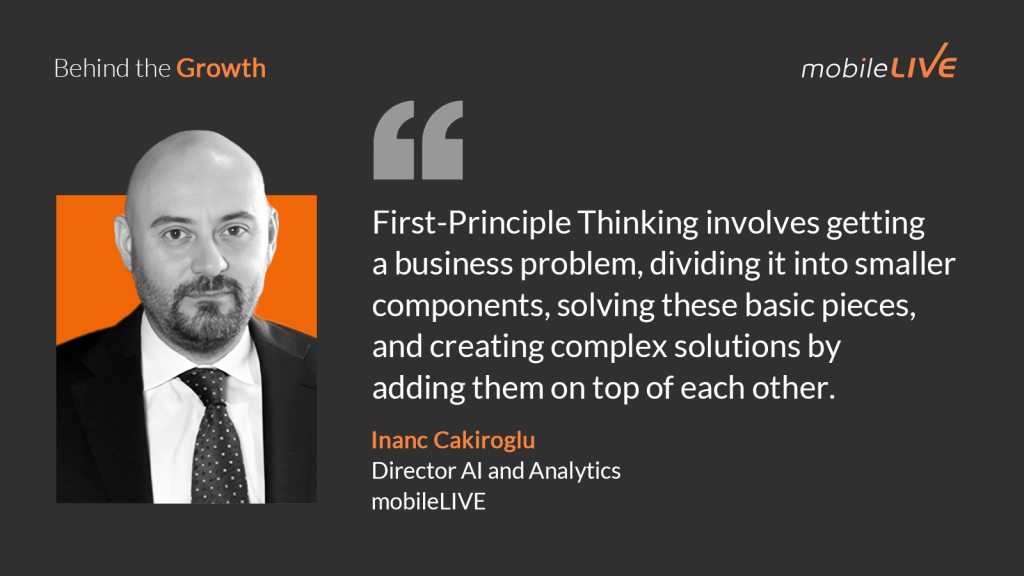Key Insights
Start with Simple Problems
First principle thinking emphasizes breaking down a business problem into its most basic elements before building up to complex solutions. This approach helps in identifying the core issues and systematically solving them. By focusing on the fundamental aspects of a problem, businesses can create robust solutions that are easier to implement and scale. This method is particularly useful in AI, where understanding the basic building blocks can lead to more effective and innovative applications.
Quality Data and Infrastructure Are Crucial
The success of AI projects heavily relies on the quality of data and the infrastructure supporting it. In the early 2000s, the lack of quality data and robust data pipelines posed significant challenges. However, advancements in data processing, storage, and open-source technologies have transformed how data is utilized. Efficient data management systems and powerful computing resources are now essential for leveraging AI effectively. This ensures that AI models can be trained on accurate and comprehensive datasets, leading to better outcomes.
AI Adoption Driven by Competition
Competition is a significant driver of AI adoption across various industries. Companies in highly competitive environments are more likely to invest in AI to gain a competitive edge. AI offers two main advantages: cost efficiency and differentiation. By reducing operational costs and providing unique customer experiences, AI helps companies stand out in crowded markets. In contrast, industries with less competition may not feel the same urgency to adopt AI, potentially missing out on the benefits it offers.

Episode Highlights
AI’s Early Challenges and Evolution
The early 2000s saw significant challenges in data quality and infrastructure for AI. Initially, the industry lacked the necessary data pipelines, powerful algorithms, and computing power. However, advancements in mobile and fixed broadband, along with the rise of open-source technologies, paved the way for a data-rich environment. This transformation enabled more complex and effective AI applications, marking a shift from basic business intelligence to advanced analytics and predictive modeling.
“We were lack of data, lack of quality of the data. We didn’t have established pipelines, data pipelines, established data infrastructures. Also, we lack of algorithms, powerful open source systems, powerful open source codes. We lack of the infrastructure and the compute power. So at those times, whatever we were talking about the data, analytics, it was a basically BI, business intelligence, some sort of reporting into some sort of a very simple prediction modeling. But I sensed at that time that there will be an era that we could leverage all these data, all these capabilities in a in the next level.”
Industry-Specific AI Applications
Different industries exhibit unique AI applications based on their data characteristics and operational nature. Sectors like banking, telecom, and healthcare leverage AI for process optimization, customer interaction, and predictive maintenance. Manufacturing uses AI for production pipeline optimization and quality assurance through computer vision models. Each industry adapts AI technologies to meet specific needs, showcasing the versatility and impact of AI across diverse fields.
“What I see in the markets, the companies like banks, financial institutes, telecom operators, entertainment companies, even the retail and the marketplaces. There is a variety of the data, size of the data is huge, the quality of the data is good. The both real-time and the batch data you have ability to process. And all these institutes are, there are lots of use cases because these institutes are the process-oriented institutes. There are lots of processes towards the operation side, towards the end customer side. So AI loves processes because it provides opportunity to process and optimize things.”
The Role of Big Data and Cloud Technologies
Big data and cloud technologies have been pivotal in advancing AI. The ability to process and store large volumes of data efficiently and cost-effectively has underpinned many AI developments. Cloud technologies, in particular, offer scalable and accessible resources for storing and computing data, making it easier for businesses to implement AI solutions. This technological evolution has provided the necessary infrastructure to support sophisticated AI models and applications.
“I think we should definitely mention about the evolution of the big data and our capability to process big data systems. Big data infrastructures in terms of compute power, in terms of storage, and in terms of database technologies, it provided the basis for all those investments, because without having capability of processing the data without having capability of storing the data, in an efficient and in a cost effective way, we couldn’t achieve any of those.”
Generative AI and Future Trends
The discussion covers the emergence of generative AI and its transformative impact. Inanc highlights the rapid development of generative AI technologies like ChatGPT, which have moved from academic research to practical applications in a short time. He underscores the importance of deep learning and neural networks in enabling these advancements. Additionally, he predicts significant changes in the use of AI in various fields, including healthcare, autonomous vehicles, and hyper-personalization in retail.
“Two, three years back, nobody was even mentioning about the generative AI. It was there, all the efforts were there, but nobody was talking about that because there was not something like a ChatGPT in place. And all these studies, all these works, it was on a more academic level or the more research and development level than generative AI. It just came out and now everybody, it’s a very buzzword and it’s very hype. Everybody’s talking about that. But the truth speaking, yeah, it changed a lot and it will change a lot. It will keep going to change our lives.”







